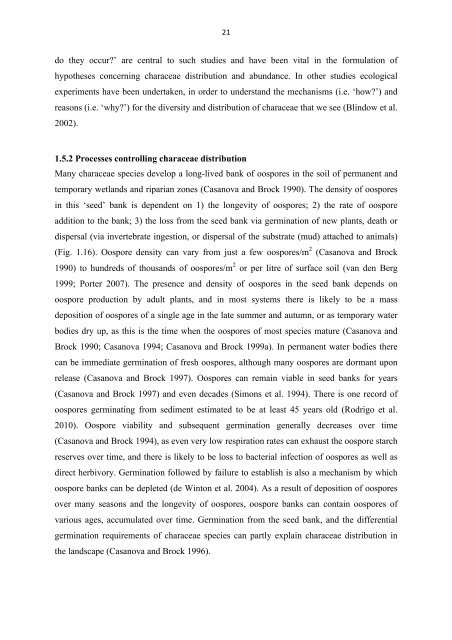Chapter 1: The Characeae Plant
Chapter 1: The Characeae Plant
Chapter 1: The Characeae Plant
Create successful ePaper yourself
Turn your PDF publications into a flip-book with our unique Google optimized e-Paper software.
21 <br />
do they occur?’ are central to such studies and have been vital in the formulation of<br />
hypotheses concerning characeae distribution and abundance. In other studies ecological<br />
experiments have been undertaken, in order to understand the mechanisms (i.e. ‘how?’) and<br />
reasons (i.e. ‘why?’) for the diversity and distribution of characeae that we see (Blindow et al.<br />
2002).<br />
1.5.2 Processes controlling characeae distribution<br />
Many characeae species develop a long-lived bank of oospores in the soil of permanent and<br />
temporary wetlands and riparian zones (Casanova and Brock 1990). <strong>The</strong> density of oospores<br />
in this ‘seed’ bank is dependent on 1) the longevity of oospores; 2) the rate of oospore<br />
addition to the bank; 3) the loss from the seed bank via germination of new plants, death or<br />
dispersal (via invertebrate ingestion, or dispersal of the substrate (mud) attached to animals)<br />
(Fig. 1.16). Oospore density can vary from just a few oospores/m 2 (Casanova and Brock<br />
1990) to hundreds of thousands of oospores/m 2 or per litre of surface soil (van den Berg<br />
1999; Porter 2007). <strong>The</strong> presence and density of oospores in the seed bank depends on<br />
oospore production by adult plants, and in most systems there is likely to be a mass<br />
deposition of oospores of a single age in the late summer and autumn, or as temporary water<br />
bodies dry up, as this is the time when the oospores of most species mature (Casanova and<br />
Brock 1990; Casanova 1994; Casanova and Brock 1999a). In permanent water bodies there<br />
can be immediate germination of fresh oospores, although many oospores are dormant upon<br />
release (Casanova and Brock 1997). Oospores can remain viable in seed banks for years<br />
(Casanova and Brock 1997) and even decades (Simons et al. 1994). <strong>The</strong>re is one record of<br />
oospores germinating from sediment estimated to be at least 45 years old (Rodrigo et al.<br />
2010). Oospore viability and subsequent germination generally decreases over time<br />
(Casanova and Brock 1994), as even very low respiration rates can exhaust the oospore starch<br />
reserves over time, and there is likely to be loss to bacterial infection of oospores as well as<br />
direct herbivory. Germination followed by failure to establish is also a mechanism by which<br />
oospore banks can be depleted (de Winton et al. 2004). As a result of deposition of oospores<br />
over many seasons and the longevity of oospores, oospore banks can contain oospores of<br />
various ages, accumulated over time. Germination from the seed bank, and the differential<br />
germination requirements of characeae species can partly explain characeae distribution in<br />
the landscape (Casanova and Brock 1996).
















